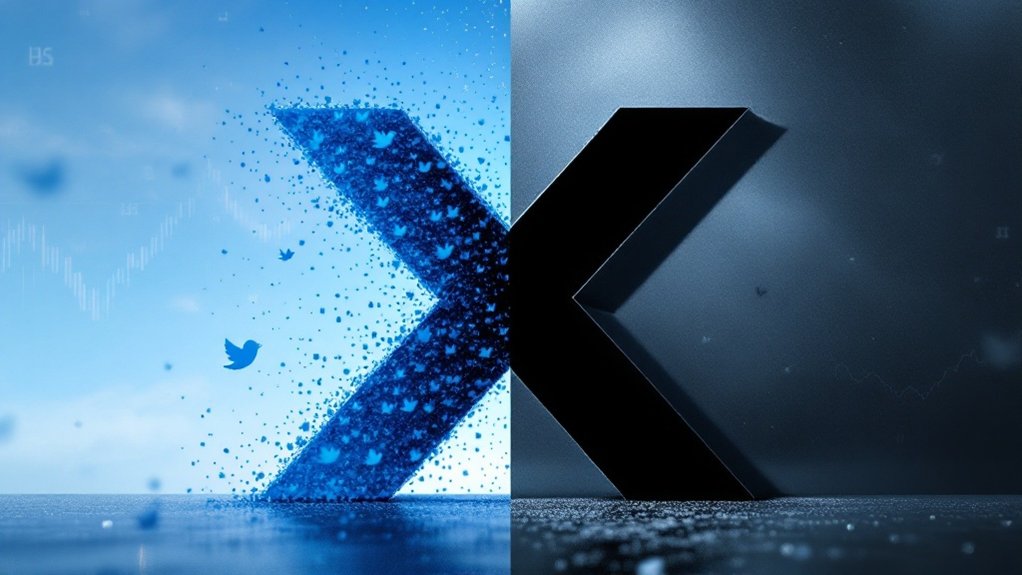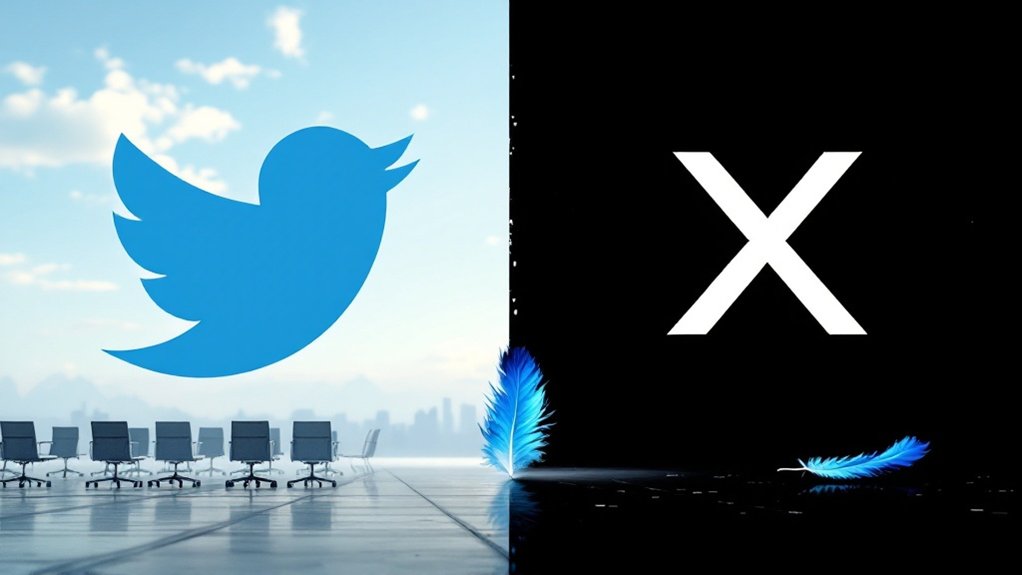Elon Musk's $44 billion Twitter takeover transformed the platform dramatically. He axed half the staff, scrapped the iconic blue bird for a minimalist "X," and upended verification by making blue checkmarks pay-to-play. Ad revenue plummeted while user numbers dropped 13%. Constant experiments followed: reading limits, blocking restrictions, and $1 fees for new users. The platform now sits at roughly 71% below purchase value. The complete story of Twitter's metamorphosis reveals even more shocking changes.

Since Elon Musk finalized his $44 billion acquisition of Twitter on October 28, 2022, the platform has undergone radical transformations that few could have predicted. The world's richest man took the company private after securing shareholder and regulatory approval, saddling himself with roughly $1 billion in annual interest payments in the process. Not bad for a guy who now controls about 79% of the company. Welcome to the new era of social media, folks.
The changes came swift and brutal. Musk immediately fired CEO Parag Agrawal along with other top executives including Segal and Gadde. Then came the bloodbath – over half of Twitter's workforce got pink slips. The company's board? Dissolved faster than an antacid tablet. Musk crowned himself king – er, CEO – until a user poll convinced him to step aside for Linda Yaccarino. While other social platforms like TikTok face national security concerns, Twitter's challenges stem from internal restructuring.
Gone is the iconic blue bird. In its place? Just "X" – minimalist, stark, and frankly, confusing to many users. Musk claims it represents free speech and innovation. Users weren't entirely convinced. The rebranding to X occurred in July 2023, completely transforming the platform's identity. The platform had experienced a 13% decline in daily active users even before the controversial rebrand took place.
The platform's verification system got a complete overhaul too – those blue checkmarks now cost money. Either pay up or lose your status. Simple as that. To combat potential impersonators, the platform implemented machine learning detection to identify suspicious behavior.
Content moderation policies shifted dramatically under Musk's watch. The platform started designating words like "cis" as slurs, implemented temporary reading limits for non-paying users, and even tried preventing people from blocking accounts. Seriously.
The financial impact has been brutal. Advertising revenue tanked post-acquisition. Twitter Blue subscriptions haven't filled the gap. The company's current valuation? Estimated at 71% less than what Musk paid. Ouch.
Musk has experimented relentlessly – reviving plans for Vine, conducting user polls for major decisions, testing $1 annual fees for new users in some countries, and removing headlines from news articles.
Love it or hate it, Twitter isn't Twitter anymore. It's X. And it's very much Elon's world now.
Frequently Asked Questions
How Has X's Revenue Model Changed Since Musk's Acquisition?
X's revenue model has undergone major shifts since Musk took over.
The company launched X Premium (formerly Twitter Blue), attracting 10 million subscribers paying for features like reduced ads and priority ranking.
There's also a new revenue-sharing program for creators.
Ad revenue has tanked—down nearly 60%—as advertisers fled the platform.
Musk's vision? Transform X into an "everything app" with messaging and payment services.
Financial challenges remain huge, with that $13 billion acquisition debt hanging overhead.
What Legal Challenges Has X Faced Under Musk's Leadership?
X has faced multiple legal battles under Musk. The SEC sued him for allegedly failing to disclose Twitter stock ownership timely, potentially costing others $150 million.
Meanwhile, X Corp is fighting California's Assembly Bill 2655, claiming it violates First Amendment rights and conflicts with Section 230. The law targets "materially deceptive content" but X calls it vague and unworkable.
Regulatory scrutiny of Musk's business dealings continues. Legal drama? Just another Tuesday for Musk.
How Did Twitter Employees Respond to Musk's Management Style?
Twitter employees largely rejected Musk's management style. Many quit after his "extremely hardcore" ultimatum demanded 80-hour workweeks.
The ban on remote work, canceled "days of rest," and emphasis on coding over design sparked immediate backlash. Some appreciated the reduced bureaucracy, sure.
But morale plummeted as stress levels skyrocketed. His transactional leadership approach—focused on efficiency over employee development—left many feeling disposable.
The result? Mass departures and a fractured workplace culture.
What Happened to Twitter's Original Founders After Musk's Takeover?
After Musk's takeover, Twitter's original founders went their separate ways.
Dorsey, who'd already stepped down as CEO in 2021, focused on Block (formerly Square).
Williams continued running Medium, his blogging platform.
Stone remained active in tech investments.
Glass, who'd left Twitter early on, stayed distant from the spotlight.
None publicly joined Musk's new vision for Twitter.
They watched from the sidelines as their creation transformed into something entirely different.
Life goes on, right?
How Has User Demographic Changed on the Platform Post-Rebrand?
Since X's rebrand, demographic shifts have been notable.
The platform remains youth-oriented, with 58% of users between 18-34. There's a significant gender imbalance – 61% male, 39% female. User engagement dropped 20%.
People are still news-hungry though, with 53% using X for information.
Interesting twist: website visits actually increased to 6.2 billion in December 2023.
The platform maintains strong presence in the US, Japan, and India. Suburban users are surprisingly active.




